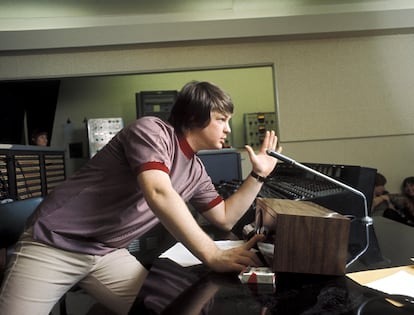The Beach Boys were two bands and they were unique
A Disney documentary revisits the Californian group with more focus on their talent than their misfortunes. For much of their careers, Brian Wilson worked in the studio while the others went on tour
As soon as The Beach Boys documentary begins, Brian Wilson, now an octogenarian, appears on screen. This is news, because the former leader of the band with the angelic voices has not been seen in public for a couple of years. He barely says a couple of sentences and at the end he joins the other surviving members of the group. He claims he remembers the music well, the lyrics, and how much fun they had. He doesn’t allude to it, but there is also bitterness in the Beach Boys’ story, despite the festive image of the blond youths in striped shirts. As cruel fate would have it, the premiere of the documentary on Disney+ coincides with the news that Wilson, a fragile genius in his mental health, has been placed under the guardianship of his manager and accountant due to dementia. Documents provided to the court by his seven children prove that since the death of his wife, Melinda, he has been unable to take care of himself or “maintain decorum.”
At the height of their success in the mid-1960s, the Beach Boys were really two bands. One, without Brian Wilson, toured and played to audiences. The other, with Brian at the helm, stayed in the Los Angeles studio with the professional musicians of The Wrecking Crew (who were much older than him), to move forward with the albums, which were just waiting for the other four band members to lay down their vocal parts when they returned from their gigs. When Brian started working on Pet Sounds (1966), the Beach Boys’ best album, the others were in Japan. He could do almost everything on his own: songwriting, arranging, producing, and playing different instruments. But he lacked the other voices, which were assembled in the magical harmonies that made the group unique.
It was the very particular way in which the band worked that placed the American dream in the collective imagination, that image of sun-drenched beaches, muscular guys with surfboards, girls in bikinis, and convertible cars. But, as the 1960s progressed, they wanted to move away from that pigeonhole and evolve into a much more complex style of pop, with artistic ambition. Brian did not feel at ease on stage as he was taking LSD and had suffered some anxiety crises; however, his talent was unhindered in the studio. The singer who had been chosen as his replacement for a series of concerts, Glen Campbell, got a big surprise the first time he traveled with the band: the fans tore his shirt and pulled out strands of his hair. There were more replacements, but the founding core remained.
The Beach Boys documentary is a journey through the ups and downs of the most emblematic vocal pop group in the U.S. — “America’s band” as they were known — and their personal struggles, which were abundant and not all of them are covered in detail. It all started in the family, but the story is far from a happy one. The three brothers (Brian, Dennis, and Carl) used to sing in the back seat of their parents’ car. Murry and Audree were fond of music: there was a piano in the house and a tape recorder on which Brian started recording his rehearsals in the garage. The three brothers, their cousin Mike Love, and their friend Al Jardine formed the first quintet. Murry saw its potential and was its biggest promoter, but he had a very dark side: he was a violent man with his family, whom he terrorized and beat. In 1964 he was ousted as producer by Brian, who had long since proved his worth. As manager he made a disastrous decision: in 1969 he sold the group’s back catalogue to a publishing house for the ridiculous figure of $700,000.

The Beach Boys managed to get radio play in 1961 with their first song, one of many about surfing. It was a timely theme because it was in demand by the record companies: there was already a musical genre associated with the sport but it was instrumental. With their tremendous voices, the Beach Boys turned it into a national phenomenon. Brian, although the absolute protagonist of the documentary, was not the only talent present at the time. Mike Love contributed a lot to the compositions and Dennis, the only true surfer had the charisma on stage and was the one the fans screamed at the most.
When they were at their peak, in 1964, Beatlemania arrived in the United States. After the Fab Four’s performance on the Ed Sullivan Show the spotlight was taken away from the Beach Boys. The documentary provides rich detail of relationship between the two bands, which was a very healthy rivalry. They admired and influenced each other, and they were competitive. They met when the Boys toured the UK and were guided in London by Keith Moon, the Who’s drummer. The connection was immediate.
When Brian heard Rubber Soul in late 1965, he was dazzled by how much the Beatles were evolving and wanted his band to take those steps forward as well. He set to work on Pet Sounds, which was tremendously innovative musically and today is considered his masterpiece, but which took a while to be understood in the U.S. His record company did not promote it much: they disliked the fact that they had abandoned the surfing cliché. However, Paul McCartney was impressed: he said it was “the best record ever made,” and the Beatles went about Sgt. Pepper’s with that powerful influence in mind (in between they had released Revolver, another outpouring of creativity; what good years those were). Although the press was determined to pit the Beatles and the Rolling Stones against each other, the former preferred to compare themselves with the Beach Boys, an eminently vocal band like them. With their 1966 single Good Vibrations, the Californians regained the number one spot that the Beatles had denied them for a couple of years.
In the ensuing years, the explosion of the hippy culture put the Beach Boys out of the game. A heavier and more psychedelic rock, in the style of Jimi Hendrix, Frank Zappa, or Led Zeppelin, began to take hold, and the Wilson’s sweet vocals did not fit in. To make matters worse, the next project after Pet Sounds, which was to be called Smile (not to be confused with Smiley Smile), was abandoned by Brian, who was feeling the wear and tear and found himself unable to finish it. That album was not released until 2004.
They may have been in decline, but that trend was reversed in 1974 when they released a compilation of the beach and party songs from their early albums (Endless Summer), which turned out to be a huge success. There was nostalgia for their innocent and simple melodies: many more compilations would follow. Then they returned to the stage, filling huge stadiums, and even Brian accepted a return to participate in the performances, although he never looked entirely happy (as seen in his expression during a concert in 1976). From then on, Brian participated intermittently: on some albums he hardly features; Bruce Johnson was brought back to act as producer and the task of composing was more distributed among all the band members.
The documentary chooses not to continue the story from there: the decadence was greater during the 1980s and 1990s, but the brand kept on making records and playing concerts. There were lawsuits between its members for the distribution of the rights and the authorship of the songs. In 2012, for their 50th anniversary, the band reunited with Brian in the lead (but without Carl and Dennis, who had died) for a final album and a tour that would prove not be the last because some of the group (led by Mike) are still reluctant to hang up the microphone. This film does not shy away from the dark moments, but it tends to address them in passing: for example, the link between Dennis and the Family, the Charles Manson cult that committed the terrible Sharon Tate crimes, is mentioned only briefly. It was one more of the many dark chapters that Dennis experienced: after that he tried going solo but he never got back on his feet, fell into addictions, went bankrupt, and drowned in 1983 at the age of 39. Carl also had an untimely death in 1998, at the age of 51, from cancer. But the Beach Boys will not be remembered for their misfortunes, of which there were many, but for their work. A music that has remained sculpted in the popular imagination of the entire world.
Sign up for our weekly newsletter to get more English-language news coverage from EL PAÍS USA Edition
Tu suscripción se está usando en otro dispositivo
¿Quieres añadir otro usuario a tu suscripción?
Si continúas leyendo en este dispositivo, no se podrá leer en el otro.
FlechaTu suscripción se está usando en otro dispositivo y solo puedes acceder a EL PAÍS desde un dispositivo a la vez.
Si quieres compartir tu cuenta, cambia tu suscripción a la modalidad Premium, así podrás añadir otro usuario. Cada uno accederá con su propia cuenta de email, lo que os permitirá personalizar vuestra experiencia en EL PAÍS.
¿Tienes una suscripción de empresa? Accede aquí para contratar más cuentas.
En el caso de no saber quién está usando tu cuenta, te recomendamos cambiar tu contraseña aquí.
Si decides continuar compartiendo tu cuenta, este mensaje se mostrará en tu dispositivo y en el de la otra persona que está usando tu cuenta de forma indefinida, afectando a tu experiencia de lectura. Puedes consultar aquí los términos y condiciones de la suscripción digital.
More information
Archived In
Últimas noticias
Most viewed
- Oona Chaplin: ‘I told James Cameron that I was living in a treehouse and starting a permaculture project with a friend’
- Sinaloa Cartel war is taking its toll on Los Chapitos
- Reinhard Genzel, Nobel laureate in physics: ‘One-minute videos will never give you the truth’
- Why the price of coffee has skyrocketed: from Brazilian plantations to specialty coffee houses
- Silver prices are going crazy: This is what’s fueling the rally












































